
1909
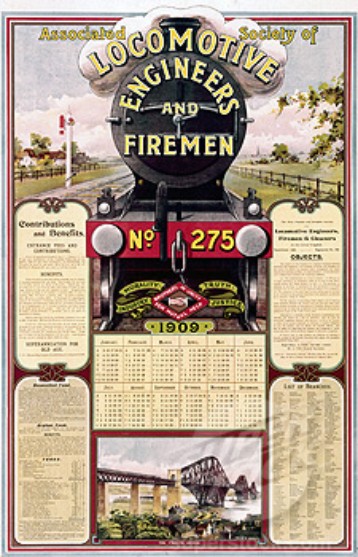
ASLEF COLECTION
Railway accident on the
L.B.S.C.R.
THE RAILWAY REVIEW
9TH APRIL 1909
L.B. & S.C. BOARDS
No. 3 Sectional Board for locomotive drivers, firemen, carriage and wagon examiners and cleaners, which recently had the national programme as affecting carriage and wagon examiners and carriage cleaners referred to them, have adjourned the whole question for twelve months. The men concerned will be, no doubt, very slow to appreciate such a settlement. This result has been brought about owing to the representatives of the men being divided on the board. The three A.S.R,S. men who represent in their district the great bulk of the carriage and wagon examiners and carriage cleaners were prepared to support the men's claims for improved conditions of service, but the three loco, men of the A.S.L.E. & F., who represent districts which have but a very few of these grades, claim that the men are satisfied with their conditions of service, and do not wish the Conciliation Boards to make any alteration. It is strange that these loco. men, who claim to represent the carriage cleaner, also claim as members of the A.S.L.E. & F. that only an engineman can represent enginemen. Unity and amalgamation are greatly needed to remove this deadlock.
THE RAILWAY REVIEW
7TH MAY 1909
Loco. Men and the Agreement.
The following correspondence has been sent to us for publication and speaks for itself:
[Copy.)
March 29th 1909
Dear Sir,-Scheme of conciliation and arbitration in respect of rates of wages and hour of
labour of railwaymen. Board of Trade agreement of 6th November, 1907.
At a meeting of locomotive-men held at Purley on the 21st inst. Mr. J.M. Bliss, one of the signatories to the above definitely stated the scheme as issued to the staff of the railways was not the same as he signed at the Board of Trade offices the scheme he signed stated the enginemen should have a Conciliation Board to themselves, but as issued to the staff they have other grades included with them, viz, coalmen, examiners, greasers, etc.
I have compared the copied of the agreement as issued by both the London and Brighton and by the South Eastern and Chatham Companies, and find them identical.
This is a serious statement for Mr. Bliss to make, and as I cannot think the Board of Trade would be a party to such alleged. I should be obliged with your assurance that Mr. Bliss has misrepresented the fact
Your obedient servant,
F. BOWERS.
G. W. Askwith, Railway Department, Board of Trade, S.W.
7, Whitehall Gardens, London, S.W.,
2nd April, 1909.
Dear Sir, - In reply to your letter of the 29th nit., I have to inform you that the scheme for conciliation and arbitration that has been by
the railway companies generally is that outlined in the agreement of November 6ch, 1907, supplementary details being arranged to suit the circumstances of each particular railway.
A copy of the agreement is enclosed herewith for your information. -
Yours faithfully
(Signed)
W.F. MARWOOD
F. Bowers, Esq.
NOTE The "outline of scheme for conciliation and arbitration" accompanying the letter is identical with that issued to the staff.
F. BOWERS.
THE RAILWAY REVIEW
28TH MAY 1909
L.B. & S.C. LOCO WORKING
The loco. working at Norwood junction appears to be in some need of revision and improvement. It is said that the turns worked from West Croydon and Stoat's Nest vary from twelve to 13 hours of duty, without a break for a meal. The engine have to be coaled from trucks standing in the sidings, no assistance being provided, the coal having to be thrown into the bunker by the men themselves. it may be of advantage to the company to work the men only five days per week in order to save overtime, but it is not very satisfactory to the men, and they would prefer six reasonable days per week.
LONDON BRIDGE TO VICTORIA
The last steam service to operate on the South London line was on Tuesday the 30th November 1909 with introduction of the Elevated Electric System starting on the following day.
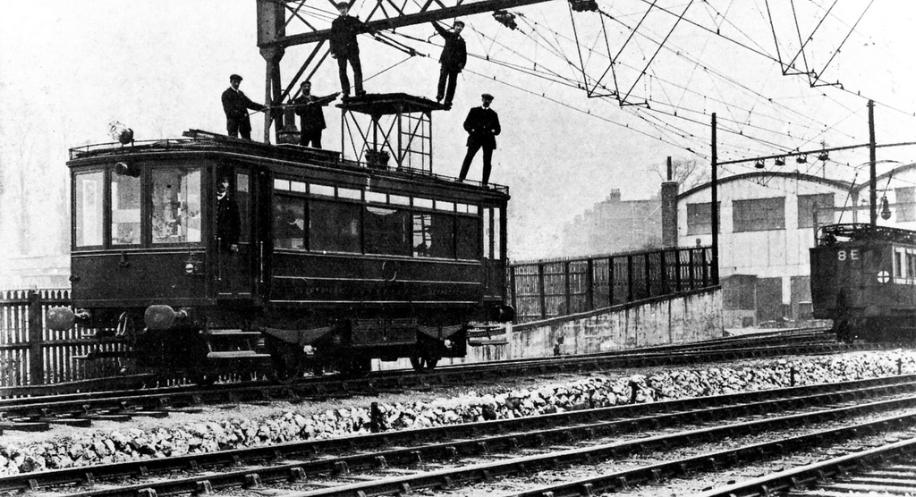
PHOTOGRAPHER UNKNOWN
PECKHAM RYE
ELEVATED ELECTRIC DEPOT
The first experimental electric train ran between Battersea Park and East Brixton on Sunday 17th, January 1909. On Sunday night, 31st January 1909. a trial run was made between Battersea Park and East Brixton, to which the press was invited. It was then stated by the L.B.S.C.R. that the Battersea Park to Peckham Rye section would be opened “very shortly,” and that it was hoped to to established the full service throughout the South London Line by June. After several postponements of opening dates, the full service between London Bridge and Victoria was inaugurated on Wednesday 1st, December., with the first train leaving London Bridge for Victoria at 7.42 a.m., and a quarterly hourly service maintained throughout the day. Both of the two London termini had dedicated electrified platforms, with London Bridge having six platforms and Victoria having five platform.
The basic service at 15 minute intervals was essentially the same as had been provided in steam days, but journey time was cut from 36 to 24 minutes. For marketing purposes the title of 'Elevated Electric' was adopted.
There was a need for a dedicated repair workshops and carriage sheds and this was erected in the V of Peckham Rye Junction, and it was here that the new electric trains were inspected, overhauled and the various maintenance requirements were carried out. A motorman’s depot was also established within the this complex. The motormen only worked these new electric trains over the the South London Line and with the expansion of the electrocution their route knowledge would expand.
At first eight 3-car units were provided,. The end motor cars had bow collectors and had
guard's accommodation and eight third class compartments. The trailer coach had nine first
class compartments, the sets seating 132 third and 56 first class passengers.
All vehicles had side gangways between compartments to improve passenger flow, and were considerably better appointed than most stock running on the Brighton main line at the time! The opportunity was taken to abolish second class, which disappeared from all suburban services in 1911 to be unsatisfactory. Already first class accommodation was excessive and overall there was excess capacity off-peak and overcrowding at peaks. The sets were re-formed into 2-car units (running in pairs at peaks).
The original motor coaches were retained coupled with driving trailers converted from bogie suburban steam stock and provided with six third and two first class compartments.The first class trailers were withdrawn and equipped for use on steam trains on the main line to Brighton, but in due course were converted again for the West Croydon and Wimbledon electrification.
See Sub page 1909 Pioneering Motormen for more details
THE PIONEERING L.B.S.C.R. MOTORMEN
The Rates of pay for the original grade of Motorman was 25shillings per week compared
to 39 shillings per week for Enginemen for this reason although Enginemen were given
the option of becoming Motormen few took up the offer. Instead most Motormen were
retrained Firemen or Guards who were already on a comparable rate of pay.
Dates of the opening of Motorman’s Depots
Peckham Rye Motorman’s Depot 17th January 1909
Selhurst Motorman’s Depot 12th May 1911
Crystal Palace Motorman’s Depot 12th May 1911
Wallington Motorman’s Depot 1st April 1925
For further Motorman’s depots see sub page 1938
Dates of initial Passenger Service AC operation
London Bridge to Victoria 1st December 1909
(via Denmark Hill )
London Bridge & Victoria to Crystal Palace 12th May 1911
(Via Streatham Hill/Tulse Hill including Tulse Hill - Streatham Hill and Crystal Palace -
Norwood Junction/Selhurst)
London Bridge to Streatham Hill to Victoria services opened on the 1st June 1911
Victoria to Victoria (via Selhurst, Norwood and Crystal Palace) services opened on the
1st June 1911
The Line between Streatham-Tulse Hill was AC electrified in 1913 but was never used in
passenger service.
Balham to East Croydon to Coulsdon North and the West Croydon to Sutton 1st April
1925
Dates of initial Passenger Service
DC operation (4th rail system)
East London Line Monday 31st March 1913
(New Cross (Gate) to Shoreditch) worked by the Metropolitan Railway. The Great
Eastern Railway continued to operated a freight inter-change service to New Cross
(Gate).
THREE BRIDGES LOCOMOTIVE SHED
The Forth Shed
The next and final shed was constructed in 1909, in open space upon an extension to the embankment carrying the Horsham lines using infill from the widening of the mainline. The new three road structure was built in brick with north-light pattern roof and tall adjacent water tank. A 60ft turntable was fitted in alongside the shed in the space between the Horsham lines, and the complex included large and small hoists, a corrugated iron machine shop with a curved roof, mess rooms and store offices, a pumping engine boiler house with its tall chimney, its fire also used for sand drying. Coal stages were provided on the north and south sides of the yard respectively, the latter improved with the addition of a canopy and crane. Over to the east was a spread of sidings known as ‘The Park’, accommodating empty coal wagons and the occasional stored locomotive. Accommodation was for around two dozen locomotives, overtaking its parent depot of Horsham and gaining separate independence status.
Up to World War 2, the allocation remained pure ‘Brighton’. It closed to steam in June 1964, Brighton taking over its remaining duties, but diesels locomotives continued to be stabled in the yard. The surviving buildings were used as a rolling stock, especially wagons, repair shops were demolished in the mid-1970s.
The workings from this shed have been described by Dick Kirby in |Vol. 15 no. 5. The shed was unique by virtue of its central position on the system, which led to its engines working regularly over most parts of the L.B.S.C.R.
Railway accidents on the
L.B.S.C.R.
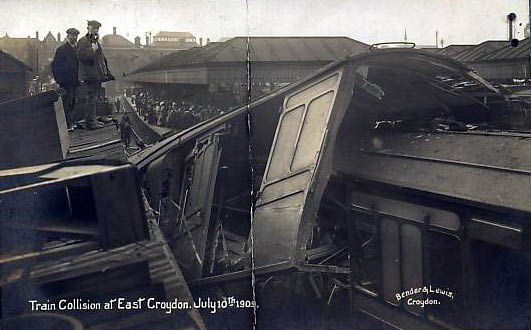
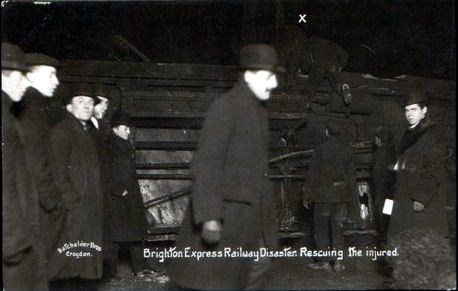
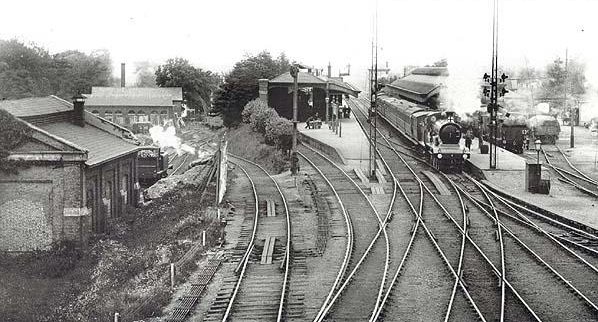
PHOTOGRAPHER UNKNOWN
Three Bridges station c1909 prior to quadrupling of the main line and the line down to the old Three Bridges Locomotive Shed.
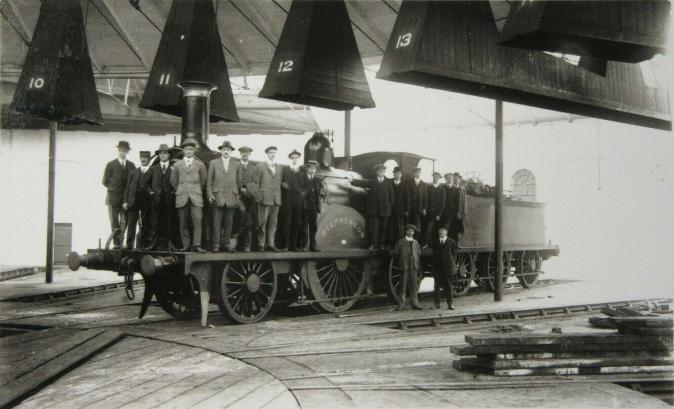
CLAYTON TUNNEL
29th DECEMBER 1909